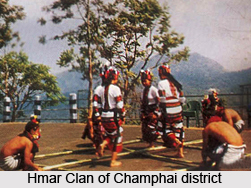History of Champhai District depicts the domination of various rulers in the region and its development as a district. Champhai district is situated in the north east of the state of Mizoram, near the India-Mayanmar border.
 The records of British government, who ruled the country in ancient times, state that Fenngo clan was the first group to migrate form east to Mizoram state from 1500-1800 AD. The village where they settled gradually were named according to their clan name as Lawihmun, Chawnchhim etc. The ancient cultural heritage of the Mizo people can still be witnessed in several areas of Champhai district. Vanhnuailiana came to this district with his companions in 1864. He later became the chief of Lawihmun whereas his mother was made the chief of Chawnchhim. After the death of Vanhnuailiana in 1871, his wife Rolianpuii became the chief of Chawnchhim and ruled over it.
The records of British government, who ruled the country in ancient times, state that Fenngo clan was the first group to migrate form east to Mizoram state from 1500-1800 AD. The village where they settled gradually were named according to their clan name as Lawihmun, Chawnchhim etc. The ancient cultural heritage of the Mizo people can still be witnessed in several areas of Champhai district. Vanhnuailiana came to this district with his companions in 1864. He later became the chief of Lawihmun whereas his mother was made the chief of Chawnchhim. After the death of Vanhnuailiana in 1871, his wife Rolianpuii became the chief of Chawnchhim and ruled over it.
On 17th of February 1872, General Bourcher and Cachar Deputy Commisioner came to Lawihmun with the purpose of making a treaty with Vanhnuailiana. On finding the village deserted, they went to Chawnchhim, the next day, and signed a treaty with the elders of Ropuiliani. In the year 1879 the sons of Vanhnuailiana namely Liankhama, Buangtheuva, Dothiauva, Chinhleia and Lalburha tried to invade the western part of Mizoram for their settlement. But they found out that the place was already captured by the descendants of Mangas, which led to the famous Chhak leh Thlang Indo war between the east and west of Mizoram.
After that Chawnchhim was captured by the British Military group. In that period, most of the villagers dwelled near the police quarters and hence knew foreign language. Having a gun licence was made compulsory for the people having a gun. This order of getting a licence was however misunderstood by the Mizo people and consequently sold out their guns to Pawi, staying in Myanmar. Thenzawl Pasaltha Chengaia then took back from Pawi, ten guns. This pleased the Deputy Commissioner and Chengaia was made the chief of Vanlaiphai. However Chengaia wanted to be the chief of Champhai.
In 1909, the 11th Deputy Commissioner of the state of Mizoram created the unique administration of Champhai. Under that administration, the chiefs of the region became the members of Panchayat. Champhai is the first place to be inhabited by the Mizo people. The district is about 100 years old and the first clan to occupy this region were Hmar clan. After their migration, it was captured by Ralte clan who were followed by Sailo clan. The end of Sailo period was marked by Lusei clan. A number of clans inhabited in the area of Champhai district. Numerous historical monuments also stand in this place including Mangkhaia lung, Chhura farep, Sikpui lung, Lungverh, Mura puk etc. Champhai was later ruled by the British rulers too.



















